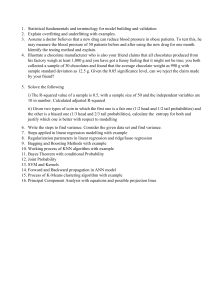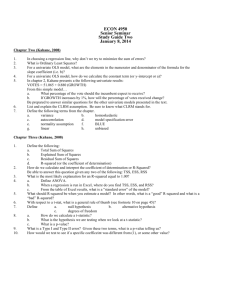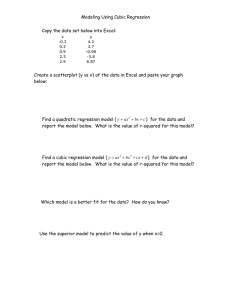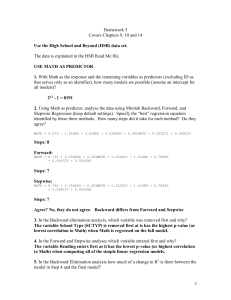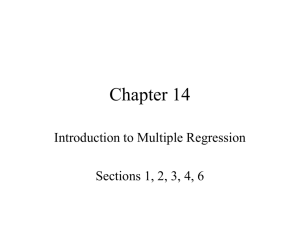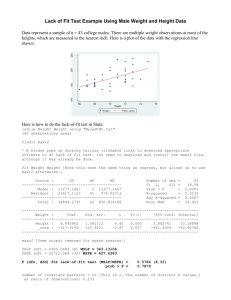Econometrics: Regression Theory - Functional Forms & R-squared
advertisement
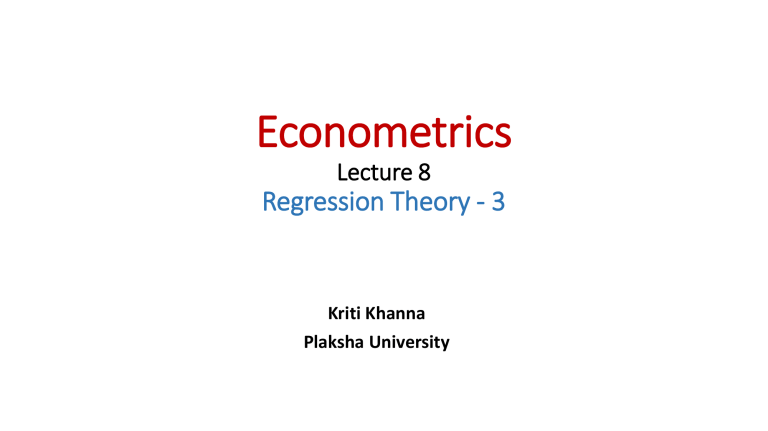
Econometrics Lecture 8 Regression Theory - 3 Kriti Khanna Plaksha University Functional Forms: Logs Functional Forms: Constant Elasticity Model • EXAMPLES: • Level-level: • Level-log: • Log-level: • Log-log: 𝑤𝑎𝑔𝑒 = 𝛽0 + 𝛽1 𝑒𝑑𝑢𝑐 + 𝑢 𝑤𝑎𝑔𝑒 = 𝛽0 + 𝛽1 log(𝑒𝑑𝑢𝑐) + 𝑢 log(𝑤𝑎𝑔𝑒) = 𝛽0 + 𝛽1 𝑒𝑑𝑢𝑐 + 𝑢 log(𝑤𝑎𝑔𝑒) = 𝛽0 + 𝛽1 log(𝑒𝑑𝑢𝑐) + 𝑢 Using logs in regression Models • Variable should take positive values • Changing units from, say, dollars to thousands of dollars has no effect on an independent variable’s coefficient when that independant variable appears in logarithmic form • Log of variable is usually taken in regression models when the range of values of the variable is large. Eg: population, salaries, sales • In many cases, taking the log greatly reduces the variation of a variable, making OLS estimates less prone to outlier influence. However, in cases where y is a fraction and close to zero for many observations, log(yi ) can have much more variability than yi . • Models with log(y) as the dependent variable often more closely satisfy the classical linear model assumptions. Model has a better chance of being linear, homoskedasticity is more likely to hold, and normality is often more plausible Models with Quadratics • A quadratic function in an explanatory variable allows for an increasing or decreasing effect at low values of rooms, an additional room has a negative effect on log(price). At some point, the effect becomes positive, log(price) is increasing as rooms increases. Models with interaction terms • Sometimes you want to see if the effect respect to an explanatory variable depends on the magnitude of yet another explanatory variable • If 𝛽3 > 0 then it implies that an additional bedroom yields a higher increase in housing price for larger houses • In other words, there is an interaction effect between square footage and number of bedrooms Effects of Attendance on Final Exam Performance • A model to explain the standardized outcome on a final exam (stndfnl) in terms of percentage of classes attended, prior college grade point average, and ACT score is • Model includes an interaction between priGPA and the attendance rate. Class attendance might have a different effect for students who have performed differently in the past, as measured by priGPA. • If we simply look at the coefficient on atndrte, we will incorrectly conclude that attendance has a negative effect on final exam score. But this coefficient supposedly measures the effect when priGPA =0 Adjusted R-squared Where, n = no. of observations in the sample p = no. of independent variables • 𝑅2 can never fall when a new independent variable is added to a regression equation: this is because SSR never goes up (and usually falls) as more independent variables are added • The Adjusted R-squared takes into account the number of independent variables used for predicting the outcome variable. In doing so, we can determine whether adding new variables to the model actually increases the model fit. Adjusted R-squared • If R-squared does not increase significantly on the addition of a new independent variable, then the value of Adjusted R-squared will actually decrease. • On the other hand, if on adding the new independent variable we see a significant increase in R-squared value, then the Adjusted R-squared value will also increase.
